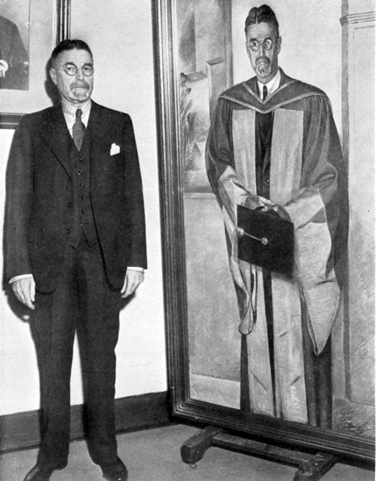Flashback
70 years ago
Lewis’ portrait of Capen presented to UB

Chancellor Samuel P. Capen stands next to his portrait painted by Wyndham Lewis at the presentation ceremony on Nov. 28, 1939.
The British artist and writer Wyndham Lewis and his wife sailed for North America on Sept. 2, 1939. Fourteen days later, they arrived at UB in search of library director Charles D. Abbott. Spending the next three months in Buffalo, Lewis attempted to secure commissions and speaking engagements; he also managed to alienate many of Buffalo’s most prominent citizens. Then in 1940, he shared his observations in “America, I Presume,” a thinly veiled fictional account of his first year in North America in which Buffalo became “Nineveh, NY” with its “Nineveh University” being, of course, UB.
Lewis and Abbott had met in England when Abbott was visiting poets and acquiring manuscripts for UB’s recently established “Poetry Project” (“He is sort of empire-building for Nineveh,” Lewis was to write). Lewis planned to wait out the war in Canada and the United States, supporting himself with commissions for portraits. While virtually unknown as an artist in North America, Lewis already had been hailed as “the greatest portraitist of this or any other time,” and many of the great British literary figures of the time had sat for his portraits.
The first week Lewis was in Buffalo, he asked Abbott to help him secure a commission. It was Thomas B. Lockwood who paid Lewis $500, with an equal amount promised upon completion of a portrait of UB’s chancellor, Samuel P. Capen. By mid-October, social engagements were scarce, as Lewis managed to offend even those people who did extend invitations. When Abbott left town for several months, it fell to Capen (“President Fortin” in Lewis’ book) to entertain the visitors. Describing Capen, or “Fortin,” Lewis said he was “not an ordinary American college president. He was a man of parts—a first-class administrator, a good scholar, and even a gentleman, which without being a rarity, still demands remark in the American scene.”
“His policies at the university were liberal. For instance, Jews who had been barred from other universities received hospitable and intelligent treatment at his hands. Even of Catholics, he was tolerant.”
“The president was a ‘good guy’ but he was no good for a party.”
Lewis attempted to hand over the Capen portrait devoid of much of the background, as evidenced by this photograph taken at the formal presentation on Nov. 28, 1939. He did return to Capen’s office several times to add the background before, against his wishes, the portrait was exhibited at the Albright Art Gallery (There was little love between the gallery’s director and Lewis).
Many thought the Capen portrait—the only official commission Lewis received in his six years in North America—was a failure and the single lecture Lewis presented in Buffalo a disaster. Capen wrote of the painting: “As it has turned out, most people seem to like it; some think it is terrible, but I suppose that is always the case.”
A contemporary reviewer described it as “a good surface likeness,” but with “a crudeness in the handling of color” and “the exaggerated Greco-esque elongation of the face and figure make less for dignified idealization than for haughty impersonality and convey none of that spiritual brilliance which is so much part of the subject.”
Almost 70 years later, the Capen portrait was one of 50 works by Lewis exhibited in the National Portrait Gallery in London. The exhibition catalogue describes Lewis as “the most important British modernist artist and writer of the first half of the 20th century.” He is “credited with revolutionizing 20th century art and literature.” Those who sat for his portraits “are the subjects of some of the greatest portraits in 20th century British art.”
Ironically, the Capen portrait was hailed for the “lean, ascetic El Greco-ish elongation of the figure and head,” for which it had been criticized seven decades earlier.
Today, the portrait hangs in UB’s Special Collections Research Room in Capen Hall and forms part of the Poetry Collection’s Wyndham Lewis holdings, an extremely rich archive of manuscripts, publications, a self-portrait and 40 drawings and sketches. It was Charles Abbott who secured the archive for UB and, when seeing the Capen portrait for the first time in early 1940, wrote to Lewis: “Really, you know, it’s a brilliant job…I knew that you could do it, and knew that you would do it; and now I am inclined to crow in the face of the doubters.”
—John Edens, University Archives

Reader Comments